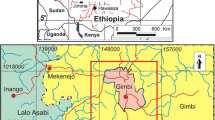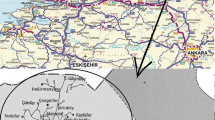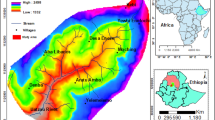Abstract
On 19 February 2007, a landslide occurred on the Alaardıç Slope, located 1.6 km south of the town of Yaka (Gelendost, Turkey.) Subsequently, the displaced materials transformed into a mud flow in Eğlence Creek and continued 750 m downstream towards the town of Yaka. The mass poised for motion in the Yaka Landslide source area and its vicinity, which would be triggered to a kinetic state by trigger factors such as heavy or sustained rainfall and/or snowmelt, poise a danger in the form of loss of life and property to Yaka with its population of 3,000. This study was undertaken to construct a susceptibility mapping of the vicinity of the Yaka Landslide’s source area and to relate it to movement of the landslide mass with the goal of prevention or mitigation of loss of life and property. The landslide susceptibility map was formulated by designating the relationship of the effecting factors that cause landslides such as lithology, gradient, slope aspect, elevation, topographical moisture index, and stream power index to the landslide map, as determined by analysis of the terrain, through the implementation of the conditional probability method. It was determined that the surface area of the Goksogut formation, which has attained lithological characteristics of clayey limestone with a broken and separated base and where area landslides occur, possesses an elevation of 1,100–1,300 m, a slope gradient of 15 °–35 ° and a slope aspect between 0 °–67.5 ° and 157 °–247 °. Loss of life and property may be avoided by the construction of structures to check the debris mass in Eğlence Creek, the cleaning of the canal which passes through Yaka, the broadening of the canal’s base area, elevating the protective edges along the canal and the establishment of a protective zone at least 10-m wide on each side of the canal to deter against damage from probable landslide occurrence and mud flow.









Similar content being viewed by others
References
Ayenew T, Barbieri G (2005) Inventory of landslide and susceptibility mapping in the Dessie area, Northern Ethiopia. Eng Geol 77:1–15
Bonham-Carter GF (1994) Geographic Information Systems for geoscientists: modelling with GIS. Pergamon, Ottawa
Bonham-Carter GF (1999) Geographic Information Systems for geoscientics: modelling with GIS. Pergamon Press, Canada, 398 pp
Carrara A (1983) Multivariate methods for landslide hazard evaluation. Math Geol 15:403–426
Carrara A, Cardinali M, Detti R, Guzzetti F, Pasqui V, Reichenbach P (1991) GIS techniques and statistical models in evaluating landslide hazard. Earth Surf Proc Land 16:427–445
Carrara A, Cardinali M, Guzzetti F, Reichenbach P (1995) GIS-based techniques for mapping landslide hazard (http://deis158.deis.unibo.it)
Chung CF, Fabbri AG, Van Westen CJ (1995) Multivariate regression analysis for landslide hazard zonation. In: Carrara A, Guzzetti F (eds) Geographical information systems in assessing natural hazards. Kluwer, Dordrecht, pp 107–133
Chung CF, Fabbri AG (1998) Three Bayesian prediction models for landslide hazard. In: Buccianti A (ed) Proceedings of International Association for Mathematical Geology 1998 Annual Meeting (IAMG.98), Ischia, Italy, October 3–7, 1998, pp 204–211
Chung CF, Fabbri AG (1999) Probabilistic prediction models for landslide hazard mapping. Photogramm Eng Remote Sens 65(12):1388–1399
Chung CF, Fabbri AG (2001) Prediction models for landslide hazard using fuzzy set approach. In: Marchetti M, Rivas V (eds) Geomorphology and environmental impact assessment. A. A. Balkema, Rotterdam, pp 31–47
Chung C, Fabbri G (2002) Modeling the conditional probability of the occurrences of future landslides in a study area characterized by spatial data. Symposium on Geospatial theory, Processing and Applications, Ottowa
Clerici A, Pergeo S, Tellini C, Vescovi P (2002) A procedure for landslide susceptibility zonation by the conditional analysis method. Geomorphology 48:349–364
Clerici A, Pergeo S, Tellini C, Vescovi P (2006) A GIS based automated procedure for landslide susceptibility mapping by the conditional analysis method: the Baganza valley case study (Italian Northern Apennines). Environ Geol 50:941–961
Dowds JP (1961) Mathematical probability as an oil-search tool. World Oil 153(3):99–106
Duman TY, Can T, Gokceoglu C, Nefeslioğlu HA (2005) Landslide susceptibility mapping of Çekmece area (Istanbul, Turkey) by conditional probability. Hydrol Earth Syst Sci Discuss 2:155–208 http://www.copernicus.org/EGU/hess/hessd/2/155/
ESRI (2005) ArcGIS 9.1. ESRI Inc., Redlands, California
Gokceoglu C, Sonmez H, Nefeslioğlu HA, Duman TY, Can T (2005) The 17 March 2005 Kuzulu Landslide (Sivas, Turkey) and landslide susceptibility map of its near vicinity. Eng Geol 81:65–83
Gorsevski PV, Gessler P, Foltz RB (2000) Spatial prediction of landslide hazard using logistic regression and GIS. In: Proceedings of 4th International Conference on Integrating GIS and environmental modelling: problems, prospects and research needs, Banff, Alberta, 2–8 September 25–27
Gorseveski P (2001) Statistical modeling of landslide hazard using GIS. Proceeding of the earth science federal Interagency Sedimentation Conference, 25–29 March, Reno, Nevada
Gülkan P, Yücemen S, Koçyiğit A, Doyuran V, Başgöz N (1993) Earthquake zoning map of Turkey based on recent data. METU Earthquake Research center, Pub. 93–01 (156 pp, in Turkish)
Guzetti F, Carrara A, Cardinali M, Reichenbach P (1999) Landslide hazard evaluation: a review of current techniques and their application in a multi-scale study, Central Italy. Geomorphology 31:181–216
Harbaugh JW, Dovedton JH, Dawis JC (1977) Probability methods in oil exploration. Wiley, New York
Jade S, Sarkar S (1993) Statistical models for slope stability classification. Eng Geol 36:91–98
Lee S, Choi J (2004) Landslide susceptibility map using GIS and the weight of evidence model. Int J Geogr Inf Sci 18(8):789–814
Lee S, Choi J, Min K (2002) Landslide susceptibility analysis and verification using the Bayesian probability model. Env Geol 43:121–130
Lei Z, Huang J (2006) GIS_based logistic regression method for landslide susceptibility mapping in regional scale. J Zhejiang University Sci A 7(12):2007–2017
Moore ID, Grayson RB, Ladson AR (1991) Digital terrain modelling: a review of hydrological, geomorphological, and biological applications. Hydrol Process 5(1):3–30
Moore ID, Grayson RB, Ladson AR (1993) Digital terrain modeling: a review of hydrological, geomorphological, and biological applications. In: Beven KJ, Moore ID (eds) Terrain analysis and distributed modeling in hydrology. Advances in hydrological processes. Wiley, Chichester
Morgan GC (1991) Quantification of risks from slope hazards. Geological Survey of Canada Open File Report, 1992–1915
Negnevitsky M (2002) Artificial ıntelligence—a guide to ıntelligent systems. Addison–Wesley Co., UK, p 394
Phi NQ, Bac BH (2004) Landslide hazard mapping using Bayesian Approach in GIS—Case study in Yangsan area, Korea. International Symposium on Geoinformatics for Spatial Infrastructure in Earth and Allied Science
Soeters R, van Westen CJ (1996) Slope instability recognition, analysis, and zonation. In: Turner AK, Schuster RL (eds) Landslides: investigation and mitigation. Transportation Research Board Special Report 247, pp 129–177
TAUDEM (Terrain analysis using digital elevation models) (2005) http://www.engineering.usu.edu/dturb/
Van Westen CJ (1994) GIS in landslide hazard zonation: a review with examples from the Colombian Andes. In: Price MF, Heywood DI (eds) Taylor and Francis, London, pp 35–65
Wang H, Liu G, Xu W, Wang G (2005) GIS-based landslide hazard assessment: an overview Progress in Physical Geography 29(4):548–567
Wilson DJ, Gallant JC (2000) Digital terrain analysis. In: Wilson DJ, Gallant JC (eds) Terrain analysis: principles and applications. Wiley, New York, pp 1–27
Author information
Authors and Affiliations
Corresponding author
Rights and permissions
About this article
Cite this article
Ozdemir, A. Landslide susceptibility mapping of vicinity of Yaka Landslide (Gelendost, Turkey) using conditional probability approach in GIS. Environ Geol 57, 1675–1686 (2009). https://doi.org/10.1007/s00254-008-1449-z
Received:
Accepted:
Published:
Issue Date:
DOI: https://doi.org/10.1007/s00254-008-1449-z




